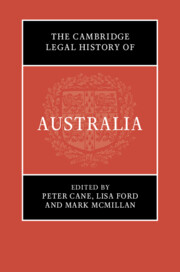Book contents
- The Cambridge Legal History of Australia
- The Cambridge Legal History of Australia
- Copyright page
- Contents
- Figures
- Maps
- Contributors
- Maps
- 1 Editors’ Introduction
- I Cultures of Law
- II Public Authority
- 5 Colonial Settlement to Colony
- 6 Colonial Self-government
- 7 Federation
- 8 Constitutionalism in Australia
- 9 Indigenous Governance
- III Public Authorities in Encounter
- IV Land and Environment
- V Social Organisation
- VI Social Ordering
- VII Reckonings
- Index
5 - Colonial Settlement to Colony
from II - Public Authority
Published online by Cambridge University Press: 04 August 2022
- The Cambridge Legal History of Australia
- The Cambridge Legal History of Australia
- Copyright page
- Contents
- Figures
- Maps
- Contributors
- Maps
- 1 Editors’ Introduction
- I Cultures of Law
- II Public Authority
- 5 Colonial Settlement to Colony
- 6 Colonial Self-government
- 7 Federation
- 8 Constitutionalism in Australia
- 9 Indigenous Governance
- III Public Authorities in Encounter
- IV Land and Environment
- V Social Organisation
- VI Social Ordering
- VII Reckonings
- Index
Summary
The legal structure of the first half century of colonial New South Wales had a military appearance. The first judges had the military title of Judge Advocate and the criminal court’s jury consisted of military officers. The colony’s initial constitution was autocratic, most of its powers being in the hands of the governors. Despite these restrictions, the colony’s courts applied civilian rather than military law. They were also the location for resistance to autocracy. English law arrived with the First Fleet in 1788, but it met new conditions. Most of the population were convicts who should have had limited legal rights, land holding had a different social function in the colony, and the invasion of indigenous interests could not be ignored entirely. After the military coup against Governor Bligh in 1808, the British government strengthened its controls, but only with a small reduction in autocratic government. The early amateur period was replaced by a professional judiciary, and in 1824 a new legislature began to limit the law-making powers of the governors. Despite these changes, English law continued to be altered to meet local circumstances.
Keywords
- Type
- Chapter
- Information
- The Cambridge Legal History of Australia , pp. 87 - 107Publisher: Cambridge University PressPrint publication year: 2022



